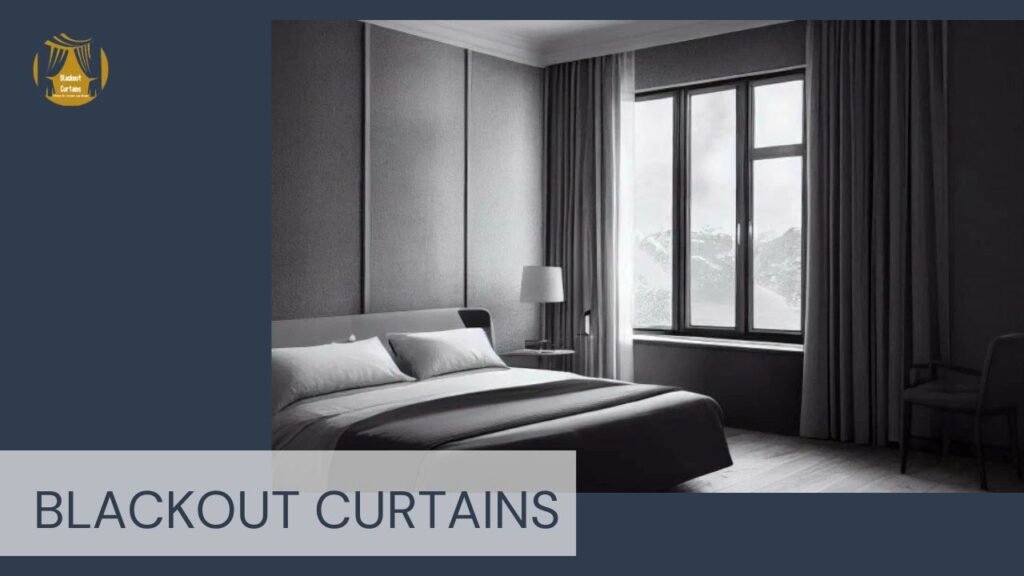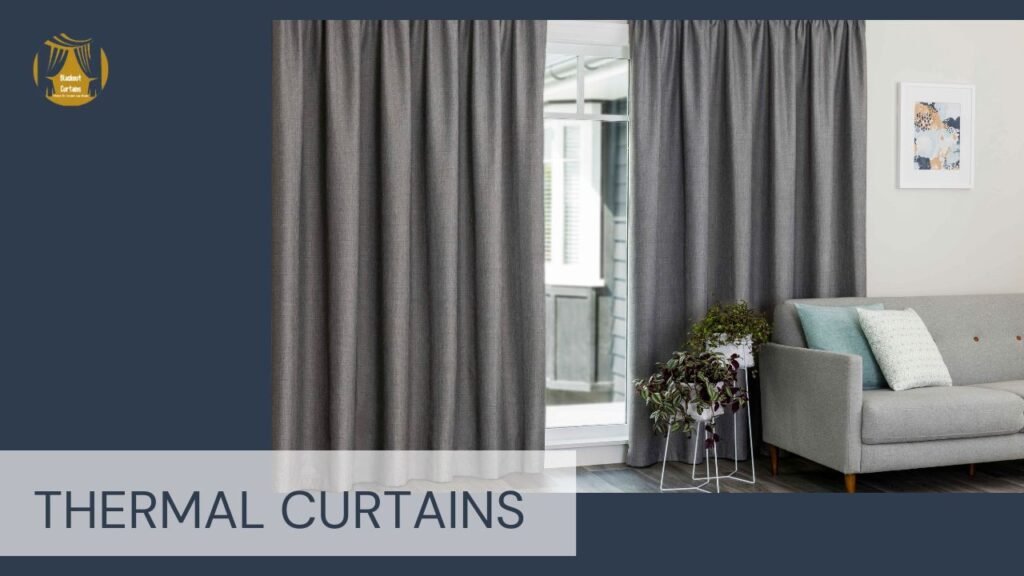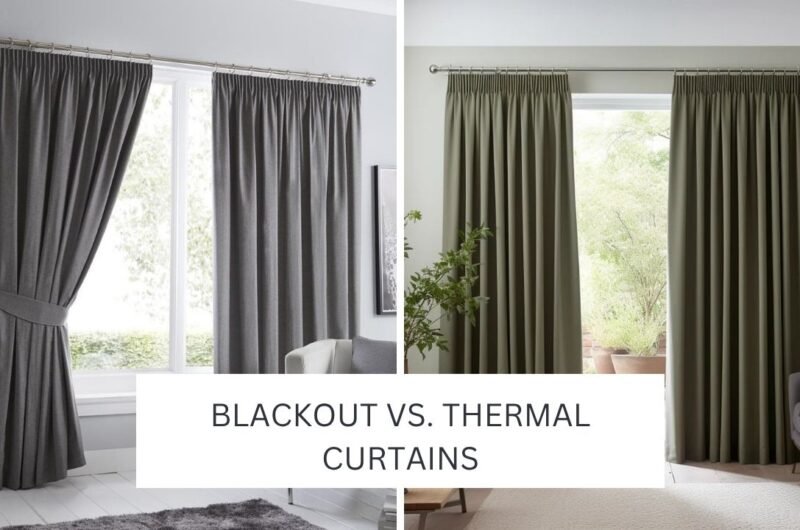When it comes to choosing the right window treatments for your home, two of the most popular options are blackout curtains and thermal curtains. While they may look similar at first glance, each type serves a different primary purpose and offers unique benefits. Whether you’re looking to create a dark, restful bedroom or improve your home’s energy efficiency, understanding the differences between these two curtain types will help you make an informed decision.
What Are Blackout Curtains?

Blackout curtains are made from thick, tightly woven fabrics that prevent light from passing through. Many of them also have a special backing (often rubberized or foam-coated) that enhances their ability to block light. These curtains are commonly used in bedrooms, nurseries, home theaters, and any space where minimizing external light is essential.
Key Features of Blackout Curtains
✔ Light Blocking: The most important feature of blackout curtains is their ability to eliminate almost all incoming light. This makes them perfect for people who need to sleep during the day, such as shift workers, or those who want uninterrupted nighttime sleep.
✔ Privacy: Because of their dense fabric and lack of transparency, blackout curtains provide excellent privacy. People outside cannot see inside the room, even when the lights are on.
✔ Noise Reduction: Due to their thickness, blackout curtains also help absorb ambient noise, making them a great option for homes near busy streets or noisy environments.
✔ Insulation (in some cases): While not all blackout curtains are designed for insulation, many high-quality ones include thermal linings that help regulate indoor temperatures by reducing heat loss in winter and heat gain in summer.
Common Uses of Blackout Curtains
✔ Bedrooms: Ideal for promoting better sleep by blocking out early morning sunlight or artificial outdoor lighting.
✔ Nurseries: Help babies and young children maintain a consistent nap schedule regardless of daylight.
✔ Home Theaters: Provide the optimal environment for movie watching by eliminating glare and ambient light.
✔ Urban Living Spaces: Especially useful in cities where streetlights or neighboring buildings can cause unwanted light pollution.
✔ Rooms with TVs or Computers: Reduce screen glare and enhance visibility.
What Are Thermal Curtains?

Thermal curtains are typically made from heavy, multi-layered fabrics like velvet, flannel, or thick cotton blends. They often include a specialized lining (such as fleece, foam, or felt) that acts as an insulating barrier. This design helps reduce heat transfer through windows, improving overall indoor comfort and energy efficiency.
How Do Thermal Curtains Work?
The secret behind thermal curtains lies in their layered construction:
✔ In Winter: The thick fabric and insulating lining trap warm air inside the room, preventing it from escaping through cold windowpanes. They also act as a barrier against cold drafts, keeping your space warmer without overworking your heating system.
✔ In Summer: Thermal curtains reflect external heat away from your home, keeping the interior cooler. By reducing the amount of hot air that enters through windows, they help maintain a more comfortable indoor temperature without relying heavily on air conditioning.
Key Benefits of Thermal Curtains
✔ Energy Efficiency: By improving insulation, thermal curtains help reduce reliance on heating and cooling systems. This leads to lower utility bills and a smaller carbon footprint.
✔ Temperature Regulation: These curtains help maintain a stable indoor climate year-round, eliminating uncomfortable hot or cold spots near windows.
✔ Noise Reduction: Like blackout curtains, thermal curtains also offer sound-dampening properties due to their dense, layered construction.
✔ UV Protection: Many thermal curtains also block harmful ultraviolet rays, protecting furniture, flooring, and artwork from sun damage and fading.
✔ Durability: Because of their sturdy build, thermal curtains tend to be long-lasting and resistant to wear and tear.
Best Places to Use Thermal Curtains
✔ Living Rooms & Family Rooms: Where maintaining a comfortable indoor temperature is more important than achieving total darkness.
✔ Large Windows or Older Homes: Particularly beneficial for rooms with poorly insulated or oversized windows.
✔ Extreme Climate Zones: Homes in areas with very hot summers or freezing winters will benefit the most from the insulation properties of thermal curtains.
✔ Noisy Neighborhoods: The added noise reduction makes them ideal for urban dwellings or homes near highways.
Head to Head Comparison: Blackout vs. Thermal Curtains
To help you understand the differences and similarities between blackout and thermal curtains, let us break down their main characteristics in a direct comparison.
| Feature | Blackout Curtains | Thermal Curtains |
|---|---|---|
| Primary Purpose | Light control (to block out nearly all external light). | Temperature regulation (to provide insulation and minimize heat transfer). |
| Light Blocking Ability | Near 100 percent (ideal for complete darkness and eliminating glare). | Good but not full blackout (effectively dims a room and reduces glare). |
| Insulation Properties | Moderate to good (provides some thermal barrier as a secondary benefit). | Excellent (specifically designed for insulation, significantly reducing heat transfer). |
| Energy Efficiency | Minor benefit from reduced heat gain in summer and slight heat retention in winter. | Major benefit from improved insulation, leading to noticeable reductions in heating and cooling costs. |
| Noise Reduction | Very effective due to their dense construction, absorbing sound waves. | Very effective, often with a slight edge due to their typically thicker, multi layered construction. |
| Best For | Bedrooms, nurseries, home theaters, urban living spaces, or any room requiring absolute darkness. | Living rooms, dining rooms, rooms with large or poorly insulated windows, homes in extreme climates, or where energy savings are a priority. |
Choosing the Right Option for Your Home
Deciding between blackout, thermal, or dual-purpose curtains depends on your specific needs and lifestyle.
If your main goal is to achieve total darkness, for example, if you’re a night-shift worker trying to sleep during the day, or you have a baby who needs consistent naps, blackout curtains are the best choice. Look for curtains with a dedicated blackout backing for maximum effectiveness.
If you live in an area with extreme weather conditions or want to reduce your heating and cooling costs, thermal curtains are the way to go. Their insulation properties will help keep your home comfortable while lowering your energy bills.
If you want both darkness and temperature control, consider purchasing dual-purpose blackout and thermal curtains. Alternatively, you could layer two types of curtains, one for light blocking and one for insulation.
Also Read: How to Layer Sheer and Blackout Curtains
Conclusion
Understanding the differences between blackout and thermal curtains is essential for making the right choice for your home. Blackout curtains excel at eliminating light, making them ideal for bedrooms, nurseries, and media rooms. Thermal curtains focus on insulation and energy efficiency, making them perfect for living rooms, large windows, or homes in extreme climates.




